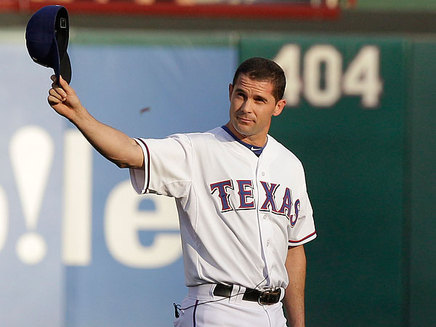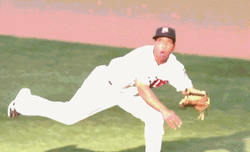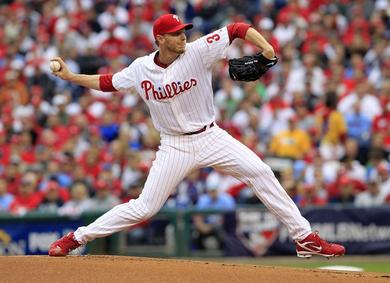After years of requesting for a trade, Michael Young has finally received his wish from the Rangers' front office. Young, 36, is heading to the Philadelphia Phillies for reliever Josh Lindblom and minor league pitcher Lisalverto Bonilla. The Rangers will pick up $10 million on Young's $16 million tab for the 2013 season. The trade was pending Young's agreement to waive his no-trade clause.
Michael Young was the face of post-Alex Rodrguez baseball in Arlington. During his tenure with the red, white, and blue, Young hit .301/.347/.444 while spending time at every infield position and DH. Additionally, Young had become the Ranger's all-time leader in games played, hits, doubles, and runs, all the while becoming one of the most popular and well respected players in team history. However, the Phillies are not receiving the player that accomplished all of those feats and accolades. Instead, they will insert Young as their starting third baseman just one year removed from one of the worst all-around seasons by anybody in recent memory. Young hit poor .277/.312/.370 (despite playing in one of the most hitter friendly parks in baseball) and was a well below average defender (-12 defensive runs saved) during his limited time in the field. He compiled a -2.4 win season (second worst WAR in 2012), which more than likely contributed to the Rangers falling one game short of the division title. Now, the Phillies are expecting a sudden rejuvenation from a player that saw his walk rate and line drive percentage decline and ground ball percentage increase by over 6 points. If you're Ben Revere and you increase your ground ball rate, that's a good thing; if you're Michael Young, however, a lot of those ground balls will end up becoming outs.
In addition, Young has experienced severe home/road splits that question his ability to hit outside of Texas' friendly confines. His home numbers (.320/.368/.479, .351 BABIP, 114 OPS+) present him to be an above average hitter while his numbers on the road (.283/.326/.410, .319 BABIP, 86 OPS+) make him look much more pedestrian. Even with Citizens Bank Park being favorable to hitters, it still does not match Arlington's offensive prowess and Young should expect his numbers to further decline. If there is one positive from Young's season, it is that he had the second lowest BABIP (35 points below career average of .334) of his career and his performance was likely further spoiled by this bad luck. Even if his BABIP returns to norm, I have a hard time believing Young will be anything above replacement level (0.0 WAR), especially so when his already atrocious defense should not take a transition to the hot corner well.
While Young gives the Phillies a strong clubhouse presence and someone who will not embarrass himself at third, is he really any better than Freddy Galvis ? Even with Young's "leadership" ability, he has complained frequently about his lack of playing time in the past, twice requesting for a trade. Ironically enough, the Rangers made the World Series the year he asked for a trade following the signing of Adrian Beltre. I am not going to try to insinuate any more about Young as a person, but can a guy's personality alone be worth $6 million? Regardless, I think it is telling alone that the Rangers would be willing to trade a franchise icon and swallow $10 million for a couple of relievers.
As for the Rangers return in the trade, relievers Josh Lindblom and Lisalverto Bonilla will be headed to the Lone Star state. Lindblom performed admirably in his 2012 rookie season, finishing with a 3.55 ERA, 110 ERA+, and an 8.9 K/9 ratio. Lindblom sits in the low to mid 90's, and flashes a plus slurve. Overall, Lindblom was a middle reliever in 2012 and should continue to be one throughout his career. As for Bonilla, he offers exciting potential after dominating (1.55 ERA, 12.4 K/9) in high A Clearwater and double A Reading. He mixes a 92-96 mph fastball and a strong changeup that features excellent movement. Some scouts believe that both of these pitches qualify as plus-plus, or elite level. He struggles with his control at times, but the Rangers added an exciting arm with the potential of a solid closer.
First Impressions
Winner: Texas Rangers. Despite losing a franchise legend, the Rangers are the victors of this trade. While the pitchers received offer only reliever upside, Young became a black hole of sorts and was overpaid. With this trade, the Rangers free up a bit of cash and should not find it hard to replace Young's on-field production.
Loser: Philadelphia Phillies. Although one would find it hard to believe that acquiring a 7-time All Star for a couple of relievers is a bad decision, this is what this trade embodies. Young really is not much of a player at this point in his career and offers little to no upside over any alternatives. While I do expect Young to rebound, it still should not be enough for the Phillies to get their money's worth.
-Aidan Flynn
Michael Young was the face of post-Alex Rodrguez baseball in Arlington. During his tenure with the red, white, and blue, Young hit .301/.347/.444 while spending time at every infield position and DH. Additionally, Young had become the Ranger's all-time leader in games played, hits, doubles, and runs, all the while becoming one of the most popular and well respected players in team history. However, the Phillies are not receiving the player that accomplished all of those feats and accolades. Instead, they will insert Young as their starting third baseman just one year removed from one of the worst all-around seasons by anybody in recent memory. Young hit poor .277/.312/.370 (despite playing in one of the most hitter friendly parks in baseball) and was a well below average defender (-12 defensive runs saved) during his limited time in the field. He compiled a -2.4 win season (second worst WAR in 2012), which more than likely contributed to the Rangers falling one game short of the division title. Now, the Phillies are expecting a sudden rejuvenation from a player that saw his walk rate and line drive percentage decline and ground ball percentage increase by over 6 points. If you're Ben Revere and you increase your ground ball rate, that's a good thing; if you're Michael Young, however, a lot of those ground balls will end up becoming outs.
In addition, Young has experienced severe home/road splits that question his ability to hit outside of Texas' friendly confines. His home numbers (.320/.368/.479, .351 BABIP, 114 OPS+) present him to be an above average hitter while his numbers on the road (.283/.326/.410, .319 BABIP, 86 OPS+) make him look much more pedestrian. Even with Citizens Bank Park being favorable to hitters, it still does not match Arlington's offensive prowess and Young should expect his numbers to further decline. If there is one positive from Young's season, it is that he had the second lowest BABIP (35 points below career average of .334) of his career and his performance was likely further spoiled by this bad luck. Even if his BABIP returns to norm, I have a hard time believing Young will be anything above replacement level (0.0 WAR), especially so when his already atrocious defense should not take a transition to the hot corner well.
While Young gives the Phillies a strong clubhouse presence and someone who will not embarrass himself at third, is he really any better than Freddy Galvis ? Even with Young's "leadership" ability, he has complained frequently about his lack of playing time in the past, twice requesting for a trade. Ironically enough, the Rangers made the World Series the year he asked for a trade following the signing of Adrian Beltre. I am not going to try to insinuate any more about Young as a person, but can a guy's personality alone be worth $6 million? Regardless, I think it is telling alone that the Rangers would be willing to trade a franchise icon and swallow $10 million for a couple of relievers.
As for the Rangers return in the trade, relievers Josh Lindblom and Lisalverto Bonilla will be headed to the Lone Star state. Lindblom performed admirably in his 2012 rookie season, finishing with a 3.55 ERA, 110 ERA+, and an 8.9 K/9 ratio. Lindblom sits in the low to mid 90's, and flashes a plus slurve. Overall, Lindblom was a middle reliever in 2012 and should continue to be one throughout his career. As for Bonilla, he offers exciting potential after dominating (1.55 ERA, 12.4 K/9) in high A Clearwater and double A Reading. He mixes a 92-96 mph fastball and a strong changeup that features excellent movement. Some scouts believe that both of these pitches qualify as plus-plus, or elite level. He struggles with his control at times, but the Rangers added an exciting arm with the potential of a solid closer.
First Impressions
Winner: Texas Rangers. Despite losing a franchise legend, the Rangers are the victors of this trade. While the pitchers received offer only reliever upside, Young became a black hole of sorts and was overpaid. With this trade, the Rangers free up a bit of cash and should not find it hard to replace Young's on-field production.
Loser: Philadelphia Phillies. Although one would find it hard to believe that acquiring a 7-time All Star for a couple of relievers is a bad decision, this is what this trade embodies. Young really is not much of a player at this point in his career and offers little to no upside over any alternatives. While I do expect Young to rebound, it still should not be enough for the Phillies to get their money's worth.
-Aidan Flynn



 RSS Feed
RSS Feed